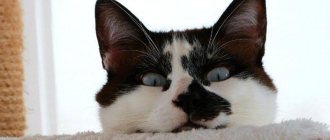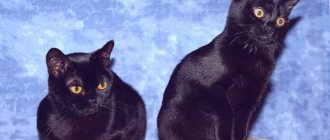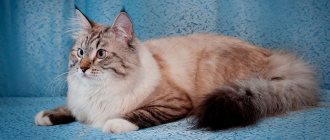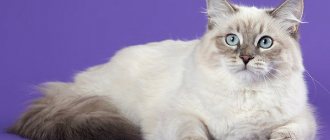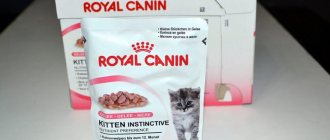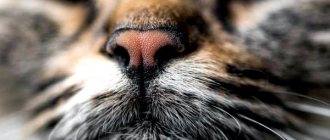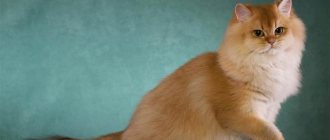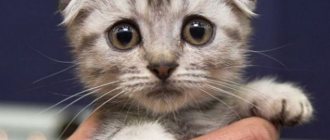- Cats
- General issues
Do you remember your tenderness when you first saw a light-colored cat “in dark socks”, with dark ears and a muzzle? And I immediately wanted to know what kind of cute creature this was. Today we will tell you about the breeds of these cats, how and when they were bred, their character and care for them.
Determination of color
Color point is a derivative of a combination of two English words: color (color) and point (point). Its visual expression is characterized by the contrasting difference between the light body of the animal and the accentuated ends of the limbs.
The most typical representative of this class is the Siamese breed, from which, apparently, the entire selection line came.
The distinctive features of the color point color appear as follows:
- light monochromatic hair on the body;
- clearly visible darkening on the legs, tail and ears;
- a contrast mask on the muzzle that can spread over its entire surface or be located only in the nose area.
The color of the limbs and its saturation depend on additional reasons.
Interesting: All colorpoint kittens are born without signs of future pigmented areas, but they appear already in the first week of life.
Color Description
If translated from English, “color” means color, and “point” means a point. Points are small dark spots located on the face, tail, paws and ears.
The usual color of a cat is solid. The pigment is evenly distributed throughout the animal’s fur and body. Therefore, you can see the uniform color of the pet.
For a color point cat, everything is completely different. Their DNA contains the cs gene, thanks to which the pigment enters only the peripheral parts of the body, that is, the cold ones. They are located at a relative distance from the warm ones. Such areas are the ears, tail, paws and muzzle.
In other parts of the body, where the temperature is relatively higher, the pigment is not able to manifest itself actively. Scientifically this is called acromelanism .
As a result, the pet’s body is painted a lighter color than the rest of the body. The overall color tone remains uniform, but only changes in its saturation and intensity. The more pronounced the border between light and dark coats is, the higher the value of such a cat for exhibition work.
Dark pigmentation can be more than just brown. There are also these colors:
Based on this, individual varieties are distinguished, for example, seal point, red point, blue point, etc. Certain breeds can combine several shades at once.
Color Dot Genetics
The CS gene is responsible for the characteristic non-standard coloring, which reacts to body temperature in its various places. Pigmentation appears in cooler areas around the extremities: paws, tail, ears and nose.
The dark pointed coat tone is passed on to the kitten from parents who have the recessive CS gene.
The next hereditary feature is the blue eyes of a cat, characteristic of albinos. It has been noted that the brighter this trait, the richer the tone of the fur on the mask and the more contrasting the difference with the color of the body - the structure of the main gene C suppresses darkening in parts with elevated temperatures, and the hairs on the limbs are controlled by the CS trait, which is activated in these places.
The final formation of a kitten's color occurs between six months and 10 months.
Interesting: In the future, even the weather and living conditions affect the color saturation - the cooler the air, the more contrasting the color-point pigmentation of the cat looks.
How to care for a Siamese cat?
Almost all breeds that have a colorpoint color as standard value the contrast between the “points” and the rest of the body. Therefore, the task of the owner of such a cat is to prevent darkening. The temperature factor has already been written above. However, other factors also influence coat color. Firstly, this is age. Almost all cats, and especially seal point cats, darken with age. Nutrition can also have an effect. It is known for sure that color changes can be caused by carrots and seaweed, which contain a lot of iodine. So, carefully read the composition of ready-made food and do not buy vitamins based on algae and kelp, and also beware of products with excess copper. Breeders notice that Thais, for example, get dark from liver, buckwheat, seafood, even beef. If there is a genetic predisposition to browning, it is better to use special food.
Such food is, for example, in the Royal Canin line. Another factor that leads to color changes, often irreversible, is any damage to the coat and skin. At the site of injury or surgery, fur grows back much darker than the surrounding background. And it’s not surprising, because the “bald” part of the body is colder. Sometimes the color evens out after molting, but not always. If the colorpoint Persian is “matted” to such an extent that it was necessary to cut off areas right down to the skin, then in these places the hair grows several tones darker. Conclusion - all colorpoints, especially exhibition ones, are undesirable for any injuries or surgeries. If you are going to have to undergo a forced operation, you should carefully choose the least noticeable place for the incision and properly insulate the seam until the fur is completely healed and grows back. It is also important to trim its claws in a timely manner so that the cat does not injure himself or injure other animals - this can ruin all the beauty.
Video
Color features
The color mask of the limbs in animals with acromelanism (incomplete albinism) varies depending on the base tone of the coat. It is never pure white, but lightens in harmony with the characteristics of the recessive CS gene.
Therefore, for example, the rich brown mask of a color-point cat accompanies a fawn shade, and red pigmentation stimulates varieties of the cream range of the color palette.
In total, the group combines about 20 different coloring options, from traditional dark to exotic lilac or wine.
Owner reviews
I could never imagine my life without some animals. I always considered everyone I had as part of the family. The cat was bought about 5 years ago. He was about a month old then. He didn’t even know how to feed himself or go to the toilet yet. Most likely, the seller needed to sell the cat as quickly as possible, so he lied a little about the baby’s readiness for independent life. In general, the kitten was named Bonya.
Color point cats are very cute and gentle kittens, and adult cats too. They are quite interesting to watch. They are funny, active and cheerful.
We bought a British Shorthair as an adult. At that time she was 10 months old. She is very clingy by nature and loves a lot of human attention. She herself jumps into her arms, but only in those cases when she exactly wants it. You can squeeze for hours, the cat is very patient.
We have a Sphynx Peterbald cat. They set up a special place for her to sleep, but she only sleeps there during the day. At night he always comes to my bed.
Solid colors
The classification of color takes into account the characteristics of pigmentation, fixing them in the name.
Seal point (black)
Cats of this group are distinguished by a deep shade of black mask (sometimes with dark brown transitions), which also covers the areas of the limbs.
The coat on the body is light, in white, beige and cream colors.
Blue point (blue)
The pigment should be clearly visible against the background of the main color. The body coat is as close as possible to cool white, but the international standard also allows gray-blue.
It is important that the mask clearly contrasts with the body and does not have stretched transition zones.
Lilac point (lilac)
They are born almost white, but quickly lose this color. The main color is characterized by warm light purple tones, and a gray-pink mask covers the limbs.
In youth, the contrast is weakly expressed, but with age it gains pigment and is easily read on the coat.
Red point (red)
Another rare representative of the color point group of cats. The color tends from white to pink or peach pastel tones, and the points are expressed by orange-red markings.
Cinnamon point (cinnamon)
Perhaps the most unique color. Obtaining offspring with this color is an undeniable success for any breeder. And if the CS gene is added, then the value of victory increases a hundredfold.
The main coat on the body in warm shades of ivory is complemented by rich brown color-point pigmentation that extends into the red spectrum.
The problem is that this variant is easily overwhelmed by other species that suppress the cinnamon shade and transfer them to their own groups.
Chocolate point (chocolate)
The chestnut-brown color of the spots and the coat in shades of ivory is a rare combination that color point kittens can boast of.
Cream point (cream)
Delicate light cream color of the cat's body with acceptable variations in all shades of baked milk. The mask on the limbs is a thick chocolate color, contrasting, with clear boundaries of the pattern.
Interesting: Cream and red kittens often have problems with classification. They completely bloom only after a year of life. Therefore, at a young age, experts often question the color of, for example, a British pointing cat.
Blue point color and character
There is an opinion (not a proven fact) that the Blue Point Scotsman is a cat with character. The fact is that the blue colors of the Scots were originally obtained from British cats, known for their temper. Modern Scottish Folds and Blue Point Scottish Straights are somewhat similar in character to the British: they are independent, willful, and can be aggressive if they don’t like something. However, the degree of expression of these qualities depends on the presence of British cats in the immediate family. If there are a lot of British people in the document, you should expect a tougher character, and vice versa. However, British genes will still be softened by Scottish ones, so such cats are more sociable and kinder than their British counterparts.
Tortoiseshells
Remarkable due to genetic characteristics is the combination of dark and reddish spots scattered throughout the body. In combination with acromelanism of color points, they lose their brightness and become poorly visible.
Seal cake point
Light beige coloring of the body and a deep dark mask of the limbs, combined with reddish tortoiseshell inserts.
Blue cake point
Pale blue coat, close to the cool gray-white spectrum, and blue-gray spots. The blue color-point color of tortoiseshell cats is complemented by faint cream shades.
Chocolate tortie point
The traditional warm, creamy color of the coat and the rich mask of the limbs are complemented by distinct reddish accents.
Lilac cake point
A kitten in lilac color is rare. Its standard characteristics (light base color and gray-pink pigmentation) are complemented by a tortoiseshell redness.
Cinnamon torty point
The cat's body has ivory-colored fur and a rich mask ranging from cream to light brown.
Interesting: Another distinctive feature of the color-point tortoiseshell is the paw pads and nose. They are two-tone, matching the shade of the adjacent coat.
Scottish Blue Point cats
The color of blue point Scottish cats (translated from English as “blue-point” means “blue dot”) is very beautiful. These are completely unique shades of light fur - the main color and shading on the paws, muzzle, ears and tail. Many people want to get just such a cat, because she is fabulously cute.
The blue point color is associated with the phenomenon of acromelanism - the dependence of the intensity of coat coloring on temperature: in places where the body temperature is higher, the coat is lighter, and vice versa. While colorful kittens are in the mother’s belly, they are completely light, because their body temperature is uniform. But within a few days after birth, Scottish Blue Point kittens begin to darken their paws, tail, face and ears due to the fact that the temperature of these parts of the body is lower than the rest. This effect is associated with the action of the enzyme tyrosinase, which is responsible for the synthesis of pigments. By the way, for the same reason, colorful cats can change color slightly depending on the air temperature - sometimes darker, sometimes lighter. In addition, this color changes with age.
The color gene in cats determines not only the color of the coat, but also the eyes, which remain blue without changing to golden in adulthood. Blue eyes are the dream of almost every cat owner. And the main thing is that in this case the blue-eyed gene is not associated with deafness, as happens in pure white murkies. As a result, we have unique shades of eyes and fur, which, as a rule, are liked by absolutely everyone, even those who can’t stand Chocleate Point cats (“chocolate point”), which are associated with Siamese and create the impression that they stuck their muzzle in chocolate.
Tabby point
A variety of dots in which a pigmented pattern is added to the main color. In this case, the mask does not cover the muzzle with a continuous fill, but is distributed symmetrically over it:
- the letter M on the forehead usually reaches the eye line or descends below it;
- spots in the roots of the mustache and in the lip area;
- the eyes are outlined with pigmented glasses;
- around the nose there is a contour to match the points.
This cat breed is also distinguished by its striped tail, on which the primary and secondary colors alternate.
Color point breeds
Not every cat can boast a pigmented variety of its breed. Targeted breeding concerns only a limited number of them.
Scottish
The main distinguishing feature of these cats is their folded ears. Small forward-curved ears with a curled tip have turned the Scottish Straight (especially with pointing spots) into a real four-legged brand.
Strong, harmoniously built, with good health and a calm character, the Scottish cat easily gets along with people.
British
The first British (at that time without a color-point mask) appeared at exhibitions a century and a half ago, although their ancestry is much older. The illustration of the Cheshire cat in the fairy-tale Alice was copied from a representative of this breed.
A large, graceful cat, with a lively look and velvety short-haired coat. An excellent companion, but only for one owner.
The British Color Point easily tolerates loneliness and jealously guards its own personal space. Does not allow familiarity and can be aggressive.
Persian
Champions in fur length among cats and owners of a characteristic flattened nose. Persia is considered the homeland of these creatures, from where they were brought to Europe. True, then they were distinguished only by long (up to 12 cm) wool.
The upturned nose of the Persian color-point is the result of the selection efforts of American breeders in the twentieth century.
Massive large body, placed on low strong paws. These cats are fluffy from the ears to the tip of the tail, with an intelligent, deep look from their wide-set eyes.
Persians are very sociable creatures, devoid of signs of obligatory dominance, characterized by a calm character and balanced psyche.
Neva Masquerade
The colorpoint mask caused the association with masquerade, and the mention of the Neva in the name refers to the place of the first selection. This is the youngest of the presented breeds, having a Russian Siberian cat as its ancestors.
Sturdy, strong, muscular animals of medium to large size. Semi-long coat in 6 color-point colors.
Affectionate and sociable, but never intrusive. They are friendly towards children and prefer to move away rather than defend themselves from annoying kids with teeth and claws.
Siamese cat
The most famous representative of the colorpoint color. An ancient breed originating in the jungles of Southeast Asia. Legends attribute to these animals the acquaintance with Buddha, the presence on the ship of the biblical Noah, and even the protection of the jewelry of the princess of Siam.
An elongated long body and a wedge-shaped head, an active character, requiring movement and tactile contact. Usually balanced in relation to the owner, but can show aggression and a desire to dominate.
A little history of the breed
Content
They are one of the oldest known breeds, descended from European domestic cats imported to England at the same time as the Roman invasion in the first century AD. Today it remains the most popular breed in its native country, as registered by the UK Governing Council for Cat Fancy (GCCF).
The origins of the British Shorthair most likely date back to the first century AD, making it one of the oldest identifiable breeds in the world.
It is believed that the Roman invasion originally brought Egyptian domestic cats to Britain. These animals were then interbred with the local European wild cat population. Over the centuries, their natural isolated descendants evolved into very large, robust beasts with short but very dense hair, to better withstand the rather harsh climatic conditions of their home islands. Based on artists' views, the modern British Shorthair is no different from this original type.
On the left you see blue colors. On the right are the tabby, red, cream and cinnamon varieties in the first photo, tortoiseshell in the second and bicolor in the third.
Selective breeding of the best specimens of this breed began in the nineteenth century, with an emphasis on developing an unusual blue-gray variant called the "British Blue" or "English type" (to distinguish it from the finer-grained "Russian").
Some sources directly credit British artist and cat lover Harrison Weir with the original concept for standardizing the breed. Others suggest that a group of breeders was involved in the selection.
The new British Shorthair was introduced at the first ever cat show, organized by Weir at the Crystal Palace in London in 1871, and enjoyed great initial popularity.
As a result, the body of the animal is colored significantly lighter than other parts of the body. In this case, the color of the coat will still correspond to the general color tone, only its intensity changes. And the lighter the body is colored, the more noticeable the border between dark and light tones is, the greater the value of this color for breeding and exhibition work.
Color point coat care
All recommendations regarding coat care relate more to breed groups than to color type. The standard procedure consists of regular combing combined with skin massage.
Long-haired breeds are prone to the formation of tangles, so they are more demanding on daily exercise. As the cat becomes dirty, it is necessary to bathe it using shampoos and sprays suitable for its coat type.
Although the article considers only purebred animals with color-point traits, the recessive CS trait can be inherited even by ordinary yard cats, which you would never suspect of purebred breeding.
Genetics is a mysterious science. It is never known what set of genes is present in the body of a meowing creature.
Maintenance and care
Almost all breeds with this color are more valuable when the contrast between the base color and the pigment parts is strong. Therefore, the main task of a person is to maintain the correct color. In addition to temperature, other factors also affect color.
The first one is age. Almost every cat darkens over time . The pet’s diet can also greatly affect the color. An indisputable fact is that carrots and seaweed, which contain a lot of iodine, can change the color of an animal. You should be careful about the composition of the feed. It is not advisable to give your cat vitamins that contain seaweed and kelp. You should not feed foods containing a lot of copper.
Experts have noticed that Thais begin to quickly turn dark when eating beef, any seafood, liver and buckwheat. If there is a predisposition, then the best solution would be to use special feed.
Any damage can also change the color of fur and even skin. In areas where injury or surgery has been performed, the fur will be much darker. This is due to the fact that that area of the body will become much colder. In some cases, color may return after the first molt, but this does not always happen.
If you definitely need to have surgery, then it is advisable to choose a place that will be least noticeable. After the procedure, it is necessary to carefully wrap the incision until complete healing.
We must not forget about trimming the claws. This should be done so that the pet cannot hurt itself.
